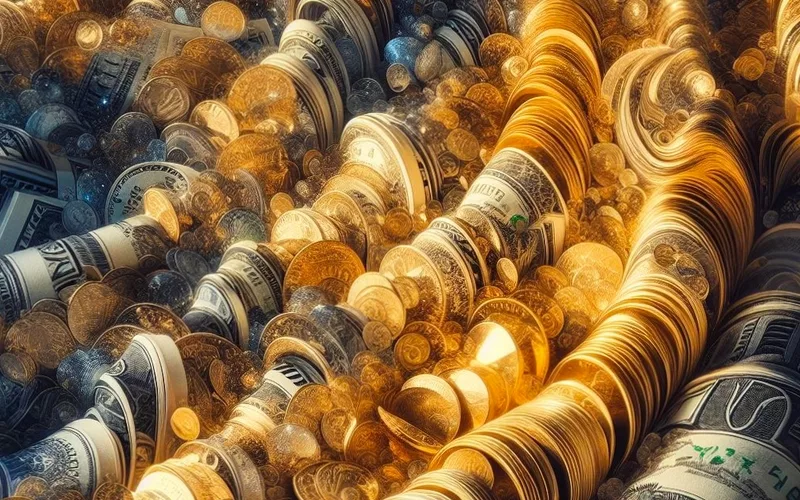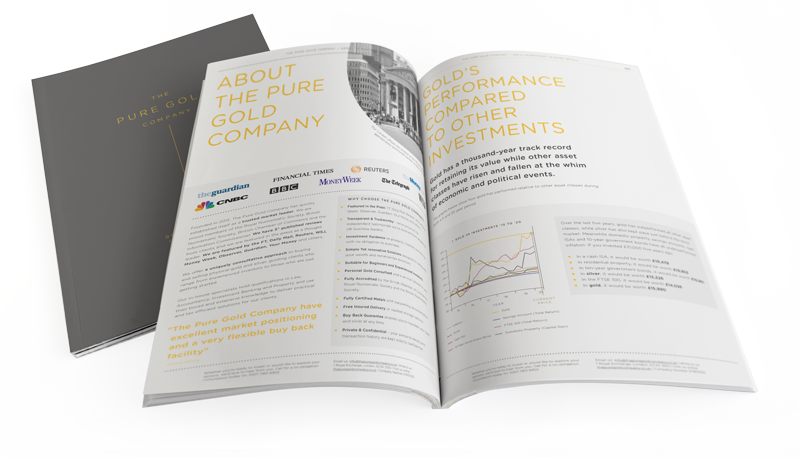The relationship between gold and money is a long and storied one. Gold is a form of money, a currency in its own right, as well as the basis for a system of paper money whose value is underwritten by gold. How did this relationship start, what did it become, and what does gold mean to us now?
The history of currency
Before money, people bartered for goods. A bushel of apples would buy a chicken, and a chicken could buy ten loaves of bread. But your barter partner had to want the bushel of apples and have a chicken to sell, or they would end up with ten loaves of bread instead. To smooth out these inherent imbalances, commodities became a form of currency. Easily tradable items like animal skins, salt and cowrie shells evolved to become the medium of exchange, which smoothed the wheels of trade and speeded up transactions.
Bronze coins were first used as currency almost 3000 years ago in China, but the first true gold coin is attributed to Croesus of Lydia in what is modern-day western Turkey in around 560 BC. These coins were of a standardised purity, stamped with an image and the weight of the coin, which contributed to the veracity of the currency. This form of gold coin proliferated around the world, with different countries minting their own coins through the millennia, like the Roman Aureus and the Spanish Doubloon, often depicting the leader of the time.
While the fortunes of gold coins waxed and waned in different parts of the world for many centuries, the Middle Ages saw a resurgence in their popularity and the Renaissance ushered in an era of intricate coin design. In the UK, the one pound sovereign (gold), guinea (gold), shilling (silver), and penny (silver, copper or bronze depending on date) was the standard currency for several hundred years until the first world war when the gold pound coin was replaced by a one pound banknote.
The gold standard
While gold coins and bars have been used for trade around the world for centuries, the gold standard was informally adopted in England in 1717, formalised in 1821, and became the international standard in 1871. The gold standard is a monetary system where the paper currency used by a country has a gold value. It was possible during the gold standard to convert your pound note or Federal Reserve dollar for its equivalent in physical gold. It also meant countries would need to hold enough gold to cover their entire issued currency.
A country that uses the gold standard will set a fixed price of gold and use the price of gold to determine the value of their currency. So, if the US price of gold is fixed at $20 and the UK price of gold is fixed at £4, then £1 would buy you $5. The international gold standard that governed monetary policy around the world between 1871 and 1914 worked effectively to keep inflation down. It did this by limiting the amount of currency that could be printed to the amount of gold held by the government. In times of peace, tying the global trade system to gold worked very well, but the start of World War I amplified the limitations of the system.
Adhering to the gold standard meant countries couldn’t print money to devalue their currency in order to make their economy more competitive internationally, or pay off debts. It was also impossible for countries to respond to crises like the war, which they needed money to fund, so they left the gold standard to be able to print more currency. After the war, a new gold standard, the Gold Exchange Standard, emerged, but it was a less rigid system that allowed for greater flexibility in the use of other currencies alongside gold.
Ultimately the gold standard was abandoned after the great depression and any remnants of the post war system dismantled by the 1970s. Even so, countries like the USA, Germany, Italy and France still hold substantial gold reserves (the UK sold over half its gold reserves between 1999 and 2002 when prices were at their lowest for 20 years; probably not one of Gordon Brown’s better decisions). These days countries work on a system of “fiat” currency (derived from the Latin word fiat, meaning a determination by authority) The government-issued currency (usually paper money) is imbued with value merely because the government says so.
Free floating gold
The US finally left the gold standard in 1971 after maintaining a gold price of $35 an ounce for 27 years. Without the constraints of a fixed gold price, gold has been allowed to fluctuate on the whim of market supply and demand. Gold’s trajectory has its fair share of peaks and troughs, but the long-term direction of travel remains up. By 1974 gold had surged fivefold to $180 an ounce, and hit around $680 in 1980 before falling back for most of the 80s and 90s and then finding a resurgence at the turn of the century. The value of gold since 200 has risen by over 550%, peaking at $2074.88 in August 2020.
What is gold to us now?
Buying investment-grade physical gold in the UK means buying coins or bars, and some of those coins are the same sovereigns used more than a century ago (albeit newly minted with the King’s head today). They are still recognised as legal tender in the UK so do not attract capital gains tax when sold (depending on individual circumstances), but trying to spend them in the local store would be unwise. Their face value continues to be just a single pound, whereas their weight in gold is worth far more than that (£1,560 in mid-October 2023).
So, while gold continues to be recognised as a form of currency in the UK, its value lies in market demand and the fluctuating gold price. Many people choose to invest in physical gold because it is recognised around the world (it retains its currency status despite the proliferation of fiat currency). Additionally, they may not trust the government issued fiat currency to maintain its value as well as gold. The rampant inflation sweeping the world for the last two years is a case in point. The aftermath of the Global Financial Crisis and the global pandemic meant central banks printed vast sums of money to stimulate sluggish economies, and the fallout has included a rapid increase in the cost of goods. Gold is a commodity so tends to increase in value as the price of goods rises. And while the relationship between gold and inflation is not perfect, gold does have a strong history of maintaining value in inflationary times.
Storing your wealth in physical gold can be an easy alternative to fiat currency because popular gold coins can be easily converted into cash (TPGC offers a buy back guarantee usually with a turnaround of 1-2 days). Even as paper money begins to disappear into the plastic credit cards and electronic wallets of the technology revolution, gold continues to be valued as a tangible currency with a long history of long-term growth.
.


